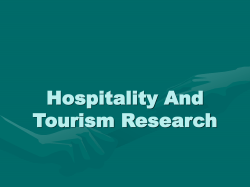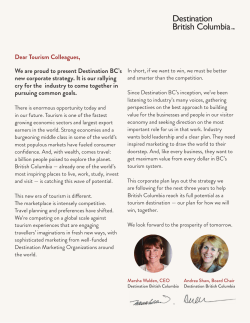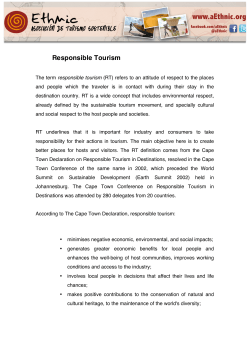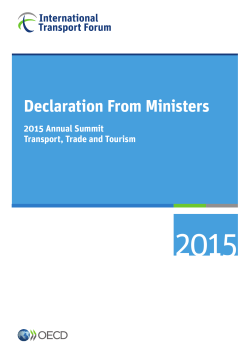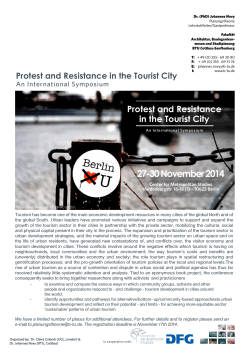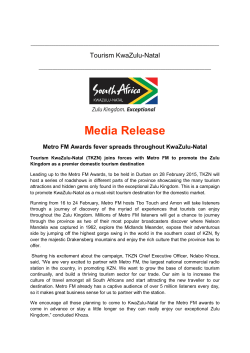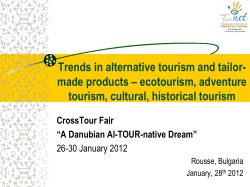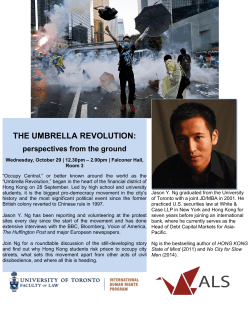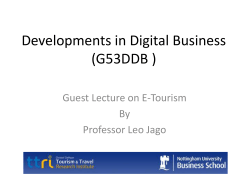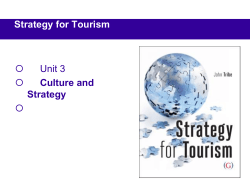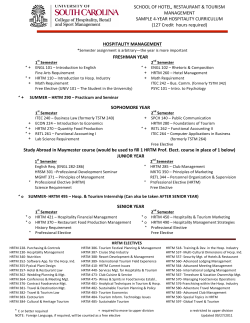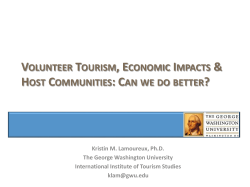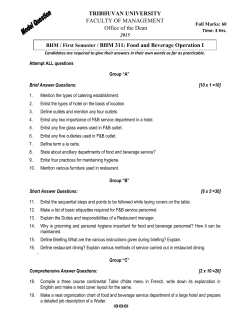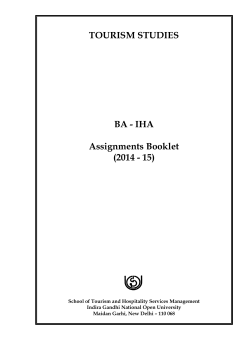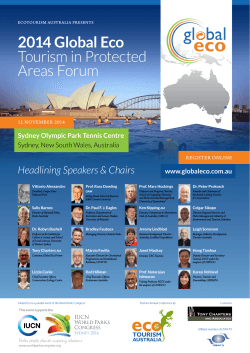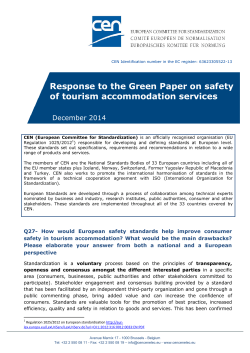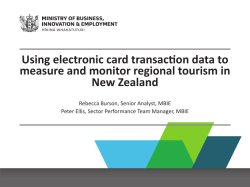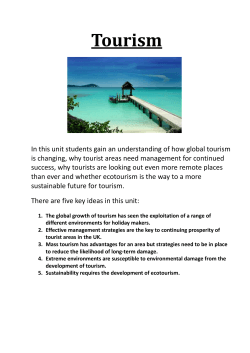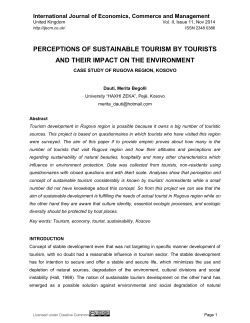
Tourism Mega Trends in Asia Pacific
Tourism Mega Trends in Asia Pacific Professor Haiyan Song Chair Professor and Associate Director School of Hotel and Tourism Management The Hong Kong Polytechnic University Introduction • • • • A Joint research project between UNWTO and Hong Kong Polytechnic University Media content analysis of travel trade magazines– TravelWeekly & TTG Asia (2005) 766 articles analyzed and 529 articles categorized into four sub-regions: North-east Asia, South-east Asia, South Asia and Oceania Use both the ‘qualitative’ text analysis software ATLAS.ti and the statistical software BiPlot to identify tourism trends in Asia-Pacific Methods Qualitative analysis provides a holistic conceptual framework that expresses relationships between codes (through ATLAS.ti’s Network View) Codes are associated with quotations that are composed of sentence(s) and paragraph(s). This results in a richer content analysis by reading ‘beyond’ keywords Visual presentation of commonalities and differences among subregional trends by conducting correspondence analysis (CA) Methods Check trends that had been previously identified and used them as a basis to further identify other trends • UNWTO (2005) Tourism Highlights 2005 identified the following trends: (1) rapid development and growth of e-commerce and e-marketing, (2) fast track travel – the facilitation and speeding up of the travel process, and (3) everyone is chasing Asian tourists Read the whole texts, created free quotations and coded them at the same time (Using ATLAS.ti) Methods Check trends that had been previously identified and used them as a basis to further identify other trends • UNWTO (2005) Tourism Highlights 2005 identified the following trends: (1) rapid development and growth of e-commerce and e-marketing, (2) fast track travel – the facilitation and speeding up of the travel process, and (3) everyone chasing Asian tourists Read the whole texts, created free quotations and coded them at the same time • 82 codes were first created and 72 of them were later combined into 18 code families (Using ATLAS.ti) Methods: Codes Families AI: Aviation Industry HI: Hotel Industry PI: Political Influence/Exchange Rate AO: Activity Oriented HR: Human Resources PO: Polarization BT: Business Travel IF: India Fever RTO: Regional Tourism Organization CC: Competition/Cooperation IM: Image/Rebranding SE: Social-Environmental Consciousness CF: China Fever IN: Infrastructure SH: Safety & Health DN: Demographic Niche Market IR: Intra-regional Travel SW: Shrinking World ED: Emerging Destination LCC: Low-cost Carriers TA: Travel Agent Transformation EE: Experience Economy MA: Marketing TC: Timely Communication ET: E-Travel MD: Multi-destination travel 2.5 RTO 2 1.5 Dimension 2 (31.49%) IF S Asia 1 MA Oceania TA 0.5 EE AI ET IR PO 0 IN SH SE SW LCC AO SE Asia 0.5 PI ED CC DN HI BT CF NE Asia IM HR MD TC 1 1.5 1 0.5 0 Dimension 1 (46.05%) 0.5 1 1.5 Trend 1: Travel becomes more activity-interest based rather than destination based More and more travellers are deciding what activities they want to partake first and then choose the destination that offers them It is therefore important for the NTOs to associate their destinations with ‘unique’ activities/offerings to induce inbound tourists Other niche activities to be considered include wellness and medical tourism Spa tourism Cruise travel is another growth market School children have been travelling overseas for the purpose of education Volunteer tourism is another emerging trend Development of integrated resorts in the region is gathering pace Trend 2: Chasing Chinese Tourists Continuous economic growth in China has generated tremendous volumes of domestic, inbound and outbound tourism activities. In 2005, China was expected to have 40 million outbound travellers, an increase of 38 percent over 2004. World Tourism Organization (WTO) predicted that by 2013, China will become the world’s number four tourist-generating country A booming economy is a result of an influx of foreign direct investment (FDI), which leads to an increase in business travel. In 2005, China attracted nearly 4 million business travellers and most of them headed to Beijing and Shanghai. With the 2008 Beijing Olympics and 2010 World Expo on the way, business travel to these two cities is expected to increase steadily Trend 3: Online travel bookings and demand for information technology keep rising The increase of online bookings and improvement of information technology will force travel agents to transform themselves into travel consultants Low-cost carries have helped to speed up this transformation by fueling online bookings • By 2007, all airlines are required by International Air Transport Association (ITA) to issue e-tickets only • Coexistence of online bookings will not replace personal touch and services Trend 4: Low-cost carriers – one of the King makers of the booming tourism Low airfares supposedly encourage more travels LCCs and rising fuel prices (fuel surcharges discourage long-haul travel) boost intra-regional (short-haul) travel LCCs’ expansion will shift to north and southwest of the region from South-east Asia Monitor the trend of exchange rates, as they are reported to be more sensitive to visitors than fuel surcharges when making travel decisions Open skies and lagging infrastructure development cause the skies to be more crowded, especially in southern China and India Trend 5: Asia Becomes a convention hub As Asia continues to be the major recipient of FDI and increase of many multinational corporations in the region, business travel within and to Asia has and will continue to grow at a rapid pace Asia will also be the most sought after location for conventions Corporations in mainland China begin to realise the importance of meeting, incentive, convention and exhibition (MICE) market, which will have tremendous growth potential Trend 6: Competition and cooperation become fierce and imperative among destinations China and India are the two major tourists generating countries and other destinations are endeavouring to tap these two markets Fierce competition also creates more cooperation e.g., Joint Singapore & Indonesia promotion Brunei twinned with Singapore Hong Kong is strengthening its alliance with Thailand, Malaysia Singapore and Regional consolidation results in coordinated marketing drives ASEAN countries are promoting their destination as a whole Countries of the Greater Mekong Sub-region (GMS) are also coordinating their joint effort in tourism infrastructure development India works with Sri Lanka to boost tourism in South Asia Middle East equally call for join promotion of the Arabian destination Trend 7: Polarization of tourists’ tastes and spending At one end are visitors seeking for comfort/luxury travel products, at the other are people looking for thrills/budget travel • Caused by the vaporization of ‘middle class’ Majority of countries/cities in Asia are targeting high-end and high yield markets signifying a shift of focus from quantity to quality Trend 8: Consolidated social-environmental awareness and consciousness One country that needs to pay special attention to this issue is China, where economic development has and continuous to put a heavy burden on its ecological environment Other regions and countries also need to pay much attention to this issue • Hong Kong (air pollution), Indonesia (haze) • Vietnam (overdevelopment in Camranh Bay and Halong Bay) and Cambodia (commercialization of Siem Reap) Indonesia was commended for its success in restoring coral reefs around Pemuteran in north Bali that revived the local communities; and Seoul’s rejuvenation of Cheong Cheon (Stream) Possible Establishment of an international reference of quality management and environmental management for the tourism industry Trend 9: Seniors and women will travel more The empty nesters are becoming the target market for many countries/regions • Japan, Hong Kong, Mainland China, Taiwan, Korea are strong drivers of this market • Thailand, Taiwan are both planning and building nursery villas to attract retirees from Japan and other countries/regions NTOs and other stakeholders of the tourism industry need to monitor closely the social trends of certain markets • Japan does not encourage long-haul travel for retired couples Family travel is another important segment that Hong Kong, Brunei, the Philippines, Singapore, Thailand and Australia are eagerly targeting The Philippines and Singapore are targeting the middle-aged and young professional female travelers • The most favorable activities for women travelers are shopping, visiting natural and scenic attractions, rest and relaxation, gourmet cuisine sampling and visiting historic and cultural attractions Trend 10: Safety and health concerns require timely communication to mitigate negative impacts on a destination The threat of pandemic outbreaks such as bird flu calls for a coordinated effort among NTOs and other government agencies Timely and accurate communication is even more important that outbreak itself Diabetes is another health concern that will have a serious impact on tourism • Action-oriented activities like soft adventure tourism and sport tourism is likely to become more popular Thank You! hmsong@polyu.edu.hk
© Copyright 2025
